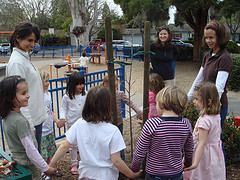PALO ALTO – On June 14, 2011, the Palo Alto Unified School District (PAUSD) adopted one of the very first School District Board of Education Policies on Trees in California. The Tree Policy was developed by members from the District’s Sustainable Schools Committee, District Staff, and Canopy, a local urban forestry nonprofit based in Palo Alto.
The President of the Board of Education, Melissa Baten Caswell says: “We value the trees on our school campuses as an important part of creating a healthy and sustainable environment for students, faculty, staff, and the community. Our thanks go out to everyone who worked to make this possible for our School District.” Bob Golton, PAUSD Co-CBO added: “This continues the wonderful spirit of cooperation in the interest of trees in our District between District staff, community members and Canopy.”
With 17 campuses covering more than 228 acres throughout Palo Alto, the District is home to hundreds of young and mature trees. The District today manages tree assessment and maintenance at twelve Elementary Schools (K-6), three Middle Schools (6-8), and two High Schools (9-12) attended by over 11,000 students. Some of these trees, particularly the native oaks, have grown alongside the schools for more than 100 years.
The District is aware of the many benefits it receives from the trees on school grounds. The Tree Policy was adopted because it seeks to provide safe, accessible, healthy and welcoming school campuses environments for current and future students. Main components of the Policy include:
• Protecting and preserving mature and heritage trees
• Utilizing trees to shade and protect children in play areas, and improve energy efficiency
• Selecting climate-appropriate, drought-tolerant, non-invasive, and native trees, whenever possible
• Incorporating tree care best practices to grow and sustain healthier trees
• Considering of new and existing trees in planning new construction, redevelopment, Bond Measure projects, and Master Planning
• Furthering student learning with curriculum-based planting and tree activities
This Tree Policy conforms to current District practices spelled out in the District’s Tree Protection Plan. The District hired a Consulting Arborist and Horticulturist to develop the plan and ensure the plan is followed and enforced. Canopy Executive Director Catherine Martineau applauded the District, and said: “Thank you for your leadership on behalf of the trees at the many schools in Palo Alto. This District is fortunate to benefit from a mature canopy, and this policy expands arboriculture best practices and tree protection measures to the largest landowner in Palo Alto not subjected to the City’s tree ordinance. By adopting this School District policy, the Palo Alto community continues to lead the way in urban forestry.”
About PAUSD
PAUSD serves approximately 11,000 students who live in most, but not all, of the City of Palo Alto, certain areas of Los Altos Hills, and Portola Valley, as well as the Stanford University campus. PAUSD is well known for its rich tradition of educational excellence and is listed among the top school districts in the state of California.
About Canopy
Canopy plants, protects, and grows local urban forests. Because trees are a critical element of a livable, sustainable urban environment, Canopy’s mission is to educate, inspire, and engage residents, businesses, and government agencies to protect and enhance our local urban forests. Canopy’s Healthy Trees, Healthy Kids! program is an initiative to plant 1,000 trees on local school campuses by 2015. Canopy is a member of the California ReLeaf Network.

